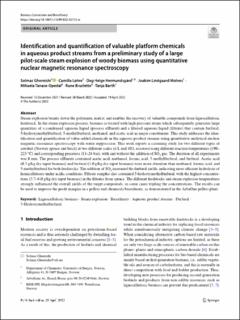| dc.description.abstract | Steam explosion breaks down the polymeric matrix and enables the recovery of valuable compounds from lignocellulosic feedstock. In the steam explosion process, biomass is treated with high-pressure steam which subsequently generates large quantities of a condensed aqueous liquid (process effluent) and a filtered aqueous liquid (filtrate) that contain furfural, 5-hydroxymethylfurfural, 5-methylfurfural, methanol, and acetic acid as major constituents. This study addresses the identification and quantification of value-added chemicals in the aqueous product streams using quantitative analytical nuclear magnetic resonance spectroscopy with water suppression. This work reports a screening study for two different types of sawdust (Norway spruce and birch) at two different scales (4 L and 10 L reactors) using different reaction temperatures (190–223 °C) and corresponding pressures (13–24 bar), with and without the addition of SO2 gas. The duration of all experiments was 8 min. The process effluents contained acetic acid, methanol, formic acid, 5-methylfurfural, and furfural. Acetic acid (0.5 g/kg dry input biomass) and furfural (1.0 g/kg dry input biomass) were more abundant than methanol, formic acid, and 5-methylfurfural for both feedstocks. The addition of SO2 increased the furfural yields, indicating more efficient hydrolysis of hemicelluloses under acidic conditions. Filtrate samples also contained 5-hydroxymethylfurfural, with the highest concentrations (5.7–6.0 g/kg dry input biomass) in the filtrates from spruce. The different feedstocks and steam explosion temperatures strongly influenced the overall yields of the target compounds, in some cases tripling the concentrations. The results can be used to improve the profit margins in a pellets and chemicals biorefinery, as demonstrated in the ArbaOne pellets plant. | en_US |

